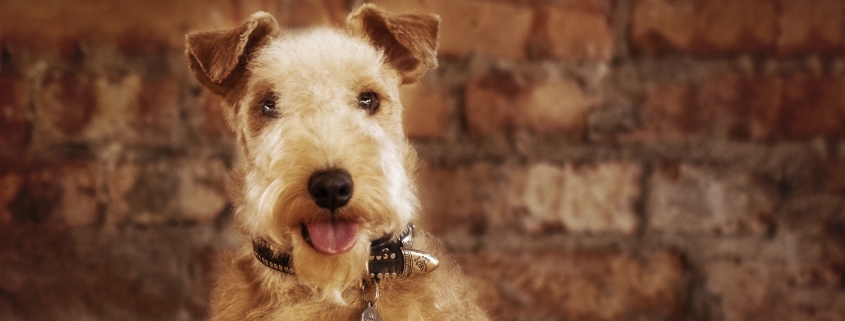By PAMELA STACE
Katerina, or Kate, our cover dog, shares her name with Shakespeare’s famous heroine Katerina from “The Taming of the Shrew.” It seems that both Kates share a number of qualities including stubbornness, intelligence, independence, loyalty and devotion.
Like Shakespeare’s Kate, Lakelands, “Lakies” or “Laplanders” do what they want to do and can be quite bold! The cover dog’s owner Nora Clark says that her girl is friendly and well-behaved but likes things her way! The “Little Tank,” as Nora calls her, loves to be out in the snow but refuses to wear a coat. She loves to play, but can get a bit rough.
History has It
The Lakeland terrier originated in Cumberland, England’s Lake District, sometime in the 19th Century. This makes it one of the oldest of the terrier breeds. As sturdy little dogs with a dense, wiry double coat, they were originally bred to work independently from humans, hunting vermin over rocky terrain. Farmers also used Lakies together with hounds to keep foxes away from their sheep during lambing season. These dogs were bred to be tough, athletic and ready to take on anything big or small that got in their way. Coming from lake country, they adore water. The Lakeland is related to the now-extinct Old English black and tan terrier, the Bedlington terrier, the Dandie Dinmont terrier and the border collie. The Lakeland terrier was recognized by the AKC in 1934 and in 2018 was ranked 138 among registered breeds.
Life at Home
Lakies can do well anywhere, but they do best with a thoughtful and understanding owner. Highly energetic, sneaky and with a mind that never stops, they not only enjoy having a daily job to do, but MUST have one. Because they are very headstrong, Lakies need early socialization and training in order to effectively channel their natural eagerness, curiosity and intelligence. They are perfectly capable of finding their own fun around the house and can get into trouble there. So it is best for their owners to find ways to keep them busy! They love people and make especially great lap dogs! Lakies can take a long time to housetrain, but with patience and persistence they will get there! They may be overly protective of their humans or aggressive around other dogs. They are very intuitive and can really tune into the health issues and moods of their owners. Lakies are good watchdogs, but it is important that they be discouraged from being too barky. They are considered non-shedding, and they are a good choice for people who are allergic to dogs. Cover dog Kate lives with cats, but Nora warned that she would not recommend this breed for those who own kittens or rodents. They do well with children who can respect their personal space.
Keeping Things Active
The Lakeland terrier loves learning, but because they are fiercely independent, they can be a challenge to train for obedience. Lakies do very well, however, in agility, conformation, tracking, rally, and especially earthdog trials, where small dogs such as terriers show off their hunting talents within constructed underground tunnels. They love navigating these courses that are similar to the narrow rocky caves of their homeland. They are becoming increasingly popular as therapy dogs.
Health of Their Own
Lakelands are generally very healthy but can suffer from genetic eye problems such as cataracts, glaucoma and lens luxation. They may also experience a blood clotting disorder called von Willebrand’s disease.
Sense of Humor Required
Lakeland terriers are impish, happy, confident and comical. Their clownish antics will make you smile and sometimes make you laugh out loud! They love being the center of attention and are more than happy to assume the role of the star when you are out walking! So owners, be prepared to let your Lakie strut their stuff.
Links: The United States Lakeland Terrier Club is the AKC parent club that supports the preservation and enhancement of the breed, as well as supervising rescue and adoption activities and encouraging sportsmanlike behavior at performance competitions. www.usltc.org
Stats: Homeland: Northern England Lake District. Original Job: Being a farm dog—hunting vermin and repelling foxes. Size: 13.5–14.5 inches, 17 lbs. Coat Colors: Colors include blue, black, liver, and red. If saddle marked, the saddle may be blue, black or liver. Grooming: Regular brushing, nail trimming and teeth brushing. For showing, meticulous hand stripping is required. Non-show dogs may be hand stripped, clipped, or allowed to have longer, shaggier coats. Exercise: Daily exercise needed. Lifespan: 12-15 years.


